#justalifelonglearner
Explore tagged Tumblr posts
Text
Water reservoir repurposed for a museum



The building that houses the Museum of History of Valencia was originally a resevoir, the first built in Valencia. It was constructed by Ildefons Cerdà and Leodegario Marchessaux for a government project to improve the water supply to the city and based on a design by Calixto Santa Cruz.
The project encompassed the catchment of water from the River Turia in the neighboring municipality of Manises, its deposit and piping, and finally its distribution throughout the city in eight public fountains, the first of which was in the Plaza del Negrito, which owes its name to the statue of an infant that presides over the fountain, blackened by the passage of time. The water system was unveiled in 1850, and was one of the first to exist in Europe.
The reservoir, with a surface area of 2600 meters squared, was originally dug out of the ground and filled with eleven brick vaults supported by 250 pillars. At full capacity, it could hold over 9000 cubic meters of water. Its location, in the outer limits of the Valencian municipality, was chosen to help it provide the necessary amount of water pressure.

#architecture#art#study notes#studyspo#Study resources#studyblr#studyinspo#lifelong learning#LifeLongLearning#justalifelonglearner
8 notes
·
View notes
Text
Woman Reading, by Henri Fantin-Latour

Henri Fantin-Latour (1836-1904) Woman Reading 1861 Oil on canvas H. 100; W. 83 cm
Musée d'Orsay
The young woman reading a book is one of the artist's sisters. At the beginning of his career, Fantin-Latour chose his models from his family circle. He also painted numerous self-portraits in this period. Woman Reading is the first painting on a theme which Fantin particularly liked. The subject, taken from Dutch painting and Chardin, enabled him to depict a person absorbed in an activity and so oblivious of the artist's work and the spectator's gaze. Fantin-Latour emphasises the meditative aspect of the scene, as when he painted young women sewing or weaving. The motionless model, the still life formed by the two books in the foreground, the subdued colours scarcely warmed by the reds of the sofa all contribute to the air of tranquillity and silence. This portrait was the first of Fantin-Latour's paintings to be accepted at the Salon, in 1861. A self-portrait had been refused in 1859. It gives a foretaste of the sobriety, simplicity and severity that characterised his later portraits.
#art#painting#european art#study notes#studyspo#Study resources#studyblr#studyinspo#lifelong learning#LifeLongLearning#justalifelonglearner
5 notes
·
View notes
Text
Sabina Seupham Spalding, by Federico de Madrazo



Sabina Seupham Spalding, by Spanish Painter Federico de Madrazo (Roma, 1815 - Madrid, 1894)
1846. Oil on Canvas, 203 x 133 cm
Currently available for viewing on the Prado Museum
#art#painting#spanish artist#spanish painting#study notes#studyspo#Study resources#studyblr#studyinspo#lifelong learning#LifeLongLearning#justalifelonglearner
11 notes
·
View notes
Text
Nature unveiling herself, by Ernest Barrias


The statue was commissioned in 1889 to decorate the new medical school in Bordeaux. A young woman, the allegory of nature, is slowly lifting the veils she is wrapped in. When he had finished the first version in white marble for the school, Barrias designed a second statue in polychrome, for the ceremonial staircase of the Conservatoire des Arts et Métiers, in Paris. He used marble and onyx from the newly reopened quarries in Algeria. Carefully carved to enhance the decorative qualities of the materials, the various parts of the statue play on the veins in the ribboned onyx for the veil, the mottled effect of the red marble for the robe, the preciousness of lapis lazuli for the eyes and malachite for the scarab and coral for the mouth and lips. The overall effect is surprisingly rich. The work belongs to a major revival of polychrome sculpture launched by archaeological discoveries and illustrated fifty years earlier by Cordier. The statue was very popular and many copies were made.
#sculpture#art#European art#study notes#studyspo#Study resources#studyblr#studyinspo#lifelong learning#LifeLongLearning#justalifelonglearner
7 notes
·
View notes
Text
Korean traditional pottery
Dragon jar
Second half of the 18th century
Porcelain jars painted with cobalt-blue dragons were popular from the seventeenth through the nineteenth century. Many were used as flower vases in official court ceremonies. Originally associated with water, dragons were also imperial emblems throughout East Asia. The two four-clawed dragons chasing flaming jewels on this piece embody the dynamic strength of the mythical beast. At the same time, their amusing, rather than savage, faces reflect the notion of dragons as auspicious, welcome creatures not to be feared.

More info at MetMuseum
Moon jar
Second half of the 18th century
A distinctive type of porcelain from the late Joseon period, the moon jar (Korean: dalhangari)—so called because of its evocative form—was usually made by joining two hemispherical halves. The peach hue of the glaze, unintentionally acquired during firing, adds to the charm of this jar.
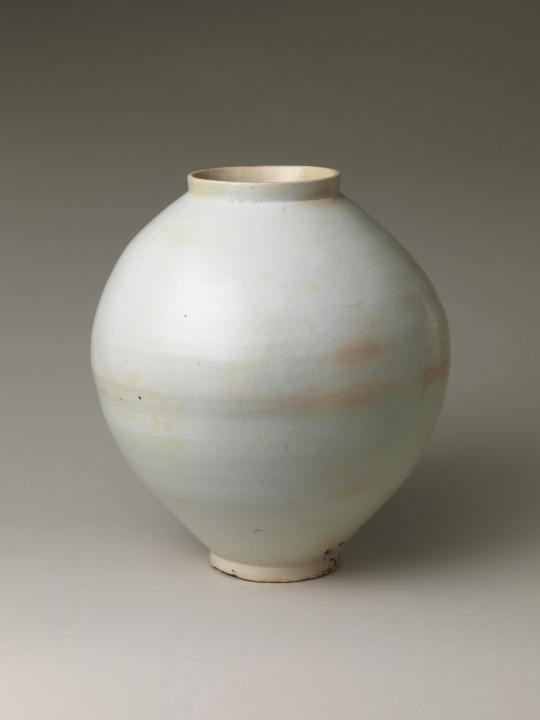
More information at MetMuseum
Brush holder with lotus decoration
Mid-19th century
Scholarly men of the Joseon dynasty collected and used tasteful accessories, such as this piece and the water droppers, for writing or painting. The lotus is an emblem of the Confucian scholar aptly used here to ornament an object for his study.

More information at MetMuseum
Ring-shaped water dropper
19th century
To prepare ink for calligraphy or painting, a Joseon scholar might have used this instrument to drip water onto an inkstone for grinding an ink stick. Porcelain water droppers, often in whimsical shapes and with or without painted decoration, were fashionable during the nineteenth century.

More information at MetMuseum
Maebyeong with lotus decoration
late 11th–early 12th century
The effect of the delicately carved lotus design under the translucent celadon glaze is subtle. Literally meaning “plum bottle,” maebyeong is a shape inspired by contemporaneous and earlier Chinese vessels. Korean celadon maebyeong developed fuller forms: broad shoulders, as in this piece, or curvilinear contours.
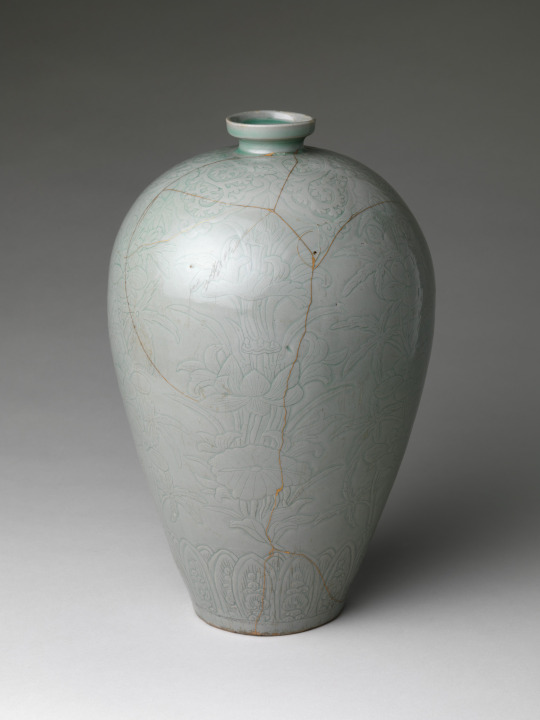
More information at MetMuseum
Maebyeong decorated with cranes and clouds
Second half of the 12th century
The cranes and clouds, popular motifs on Goryeo celadon, are delicately yet expressively rendered. Set against the green color of the glaze, they appear to be floating in the sky.

More information at MetMuseum
#art#pottery#korean pottery#history#study notes#studyspo#Study resources#studyblr#studyinspo#lifelong learning#LifeLongLearning#justalifelonglearner
9 notes
·
View notes
Text
The Lady with the Glove, by Carolus-Duran


Carolus-Duran (1837-1917) The Lady with the Glove 1869 Oil on canvas H. 228; W. 164 cm Musée d'Orsay
The Lady with the Glove, a life-sized full-length portrait of the artist's young wife, was a great success at the 1869 Salon, where it won a medal. Regarded by the critics as the archetypal formal portrait, the work shows a sober composition, masterful drawing and delicate use of colour which recall David and Ingres. Standing out from a near-empty background painted in shades of grey and black, and the dark, changing colours of the gown, three interrelated elements catch the eye: the young woman's face and fashionable hairstyle, her hands, one drawing off a pearly grey glove, and the glove on the ground underlined by the painter's signature, in red. This anecdotal detail gives the work a modern instantaneous look which helps us understand why Emile Zola saw in Carolus-Duran a disciple of Manet.
#art#painting#european art#study notes#studyspo#Study resources#studyblr#studyinspo#lifelong learning#LifeLongLearning#justalifelonglearner
1 note
·
View note
Photo

Marina (Rocas de Agaete)
1946
López Ruiz, Manuel
1 note
·
View note
Text
The Craddle, by Berthe Morisot

Berthe Morisot (1841-1895)
The Cradle - 1872
Oil on canvas, H. 56; W. 46 cm
Paris, Musée d'Orsay
Undeniably Berthe Morisot's most famous painting, The Cradle was painted in Paris in 1872. It shows one of the artist's sisters, Edma, watching over her sleeping daughter, Blanche. It is the first image of motherhood—later one of her favourite subjects—to appear in Morisot's work. The mother's gaze, her bent left arm, a mirror image of the child's arm, and the baby's closed eyes form a diagonal line which is further accentuated by the movement of the curtain in the background. This diagonal links the mother to her child. Edma's gesture, drawing the net curtain of the cradle between the spectator and the baby, further reinforces the feeling of intimacy and protective love expressed in the painting. Berthe Morisot showed The Cradle at the Impressionist exhibition of 1874—the first woman to exhibit with the group. The painting was scarcely noticed although important critics commented on its grace and elegance. After unsuccessful attempts to sell it, Berthe Morisot withdrew it from display and The Cradle stayed in the model's family until it was bought by the Louvre in 1930.
#painting#art#european art#study notes#studyspo#Study resources#studyblr#studyinspo#lifelong learning#LifeLongLearning#justalifelonglearner
3 notes
·
View notes
Text
13/08/2020
Things I intended to achieve today: wrapping things up in preparation for the holidays, tidying up my notes and pending tasks so that everything is set and prepared for the return to the holidays.-
Things I actually achieved today: running around trying unsuccessfully to close down a single task. It is mid-August, why is it so busy today?
On a better note, I am still doing the FutureLearn course on Australian Crime, and it is still proving to be quite entertaining to watch!
3 notes
·
View notes
Text
Historical notebooks
Just in case you thought PaperBlank or Peter Pauper were the highest form of notebook-decorations, just some historical notebooks, for your viewing pleasure.
Of course, these would fall more under the term “jewelry” than “notebook” but just enjoy.

Notebook in the Form of a Tablet
France, 1720-1730s
Material: gold, ivory, diamonds, silver
Technique: chasing, pouncing, polishing
Dimensions: diam. 7,3 cm
More at Hermitage Museum

Notebook Purse
France, Paris, 1740s
Material: mother-of-pearl, gold, diamonds, rubies, emeralds, amethyst, silver, silk
Technique: chasing, pouncing, polishing, carving
Dimensions: 10х7 cm
More at Hermitage Museum

Notebook Purse
France, 1700s
Material: tortoise shell, gold, silver, mother-of-pearl, cut diamonds, paper, silk
Technique: inlay, chasing, pouncing, polishing
Dimensions: 11х6,6 cm
More at Hermitage Museum

Carnet and a Mirror
France, Paris, Late 18th century
Material: gold, enamel, ivory, glass, wood
Technique: chasing, polishing, engraving, pouncing
Dimensions: 6,2х3,6х1,2 cm
More at Hermitage Museum

Notebook in the Form of a Tablet
France, 1720-1730s
Material: tortoiseshell, gold, mother-of-pearl, fabric
Technique: chasing, engraving, pouncing, inlay
Dimensions: l. 7,1 cm
More at Hermitage Museum

Notebook
France, Paris, 1760s
Material: gold, enamel, paper, fabric
Technique: polishing, chasing, engraving, pouncing, painting
Dimensions: 8,8х5,6х0,9 см
More at Hermitage Museum
#notebook#study notes#studyspo#Study resources#studyblr#studyinspo#lifelong learning#LifeLongLearning#justalifelonglearner
1 note
·
View note
Text
18/08/2020
Finished the FutureLearn course on Australian Crime! It is not a documentary, per se, but it makes you think about the way crime is represented, referred to, communicated and disseminated. It was quite entertaining.
I have just also started Introduction to Korean philosophy, so we will see how that goes!
2 notes
·
View notes
Text
18th Century French Snuff Boxes
Snuffbox, small, usually ornamented box for holding snuff (a scented, powdered tobacco).
The practice of sniffing or inhaling a pinch of snuff was common in England around the 17th century; and when, in the 18th century, it became widespread in other countries as well, the demand for decorated snuffboxes, considered valuable gifts, increased. Some were small enough to fit in a waistcoat pocket, and others were larger; all gave 18th-century craftsmen an opportunity to execute rich and elaborate designs.

France, Paris, 1755-1756
Authors: Master: Robineau, Henry Daniel, active 1754-1793
Date: 1755-1756
Material: tortoise-shell, gold
Technique: polishing, inlay, engraving
Dimensions: 8,1х4х4,2 cm
More at Hermitage Museum.

Title: Snuff-Box
Place of creation: France, Paris
Authors: Master JD (?)
Date: Circa 1740
Material: gold, mother-of-pearl
Technique: inlay, polishing, engraving
Dimensions: 6,5х4,8х2,5 cm
More at Hermitage Museum

Title: Snuff-Box with a Portrait of Peter I
Place of creation: France, Paris
Authors: Barrière, Jean-Joseph, active 1763-1793
Date: 1772-1773
Material: gold, enamel, glass
Technique: chasing, guilloching, painting
Dimensions: h. 2,7 cm; diam. 6,9 cm
More at Hermitage Museum

Title: Snuff-Box with Portraits of Louis XV and Maria Leszczyńska
Place of creation: France, Paris
Authors: Govaers, Daniel (dit Gouers), active 1717-1754; Artist: Massé, Jean-Baptiste (miniature). 1687-1767
Date: 1724-1725
Material: gold, carnelian, glass, silver, diamonds, sapphires, emerald
Technique: chasing, punching, paint red in gouache and watercolour on bone
Dimensions: 2,6х7,3х5,5 cm
More at Hermitage Museum

Title: Snuff-Box
Place of creation: France, Paris
Authors: Anonymous master
Date: 1760-1780s
Material: gold, enamel
Technique: chasing
Dimensions: h. 1,5 cm; diam. 4,3 cm
More at Hermitage Museum

Title: Snuff-Box
Place of creation: France, Paris
Authors: Master PC (?)
Date: 1760s
Material: gold, mother-of-pearl
Technique: carving, chasing, polishing, painting
Dimensions: 7,5х5,7х3,1 cm
More at Hermitage Museum
#jewelry#art#study notes#studyspo#Study resources#studyblr#studyinspo#lifelong learning#LifeLongLearning#justalifelonglearner
1 note
·
View note
Text
Kakemono (or kakejiku)
In Europe we had the tapestries, wall hanging decorations that served both the dual purpose of holding off the cold that permeated castles and palaces and for decorative purposes. But Asia, cradle of many incredibly beautiful, intricate and long-perfected arts, also had wall decorations.
Kakemono (also called Kakejiku) is a scroll that is made from either paper or silk, made for being hung up, and which includes generally some kind of art, be it either calligraphy or a painting.


On its ends, there are these thin rollers, called jiku, whose weight help ensure the surface of the roll is kept extended when hung up, and that the kakemono can be rolled up easily and compactly for storage.
Unlike makimono (which is extended horizontally), the kakemono must be rolled out and hung up vertically as part of the decoration of a room.
Why use them for decor?
Unlike biombos or shohekiga (the beautifully decorated sliding doors), kakemonos could be easily and quickly changed to be adapted to the season or the specific event.
A bit of history about kakemonos
The origins of kakemono are rooted in the Tang Dynasty of China (VIIth Century), very probably taking inspiration from sutras, that were rolled up and stored. In addition, the dissemination of mural-type paintings that came from the Tibet, would have contributed, as this format (easily portable, smaller) facilitated distribution.
It was later introduced into Japan during the Heian era (794 – 1185), although focused mostly on Buddhist representations, calligraphy or poetry.
From the Muromachi era (1336 – 1573) onwards, with the influence of Zen Buddhism, kakemono was linked with the tea ceremony. Even the motifs went a subtle transformation: landscapes, flowers, birds, portraits, although poetry remained. This made kakemonos more of an art work than an object used for religious purposes.
And what about now?
Currently, kakemonos may contain calligraphy and paintings of all genres, up an including ukiyo-e (in which case the kakemono is then called kakemono-e). Types of kakemono:If width is shorter than height: tatejikuIf width is longer than height: yokojiku
Kakemonos can also be exhibited in a group:2 kakemonos in a diptych: soufuku3 kakemonos in a triptych : sampukutsui or kakejiku4 kakemonos: yonpukutsuiThere are also groupings of 6, 8, even 12 kakemonos
What to find out more?
There are some videos that could be interesting:
youtube
youtube
youtube
youtube
8 notes
·
View notes
Text
Some Italian vocabulary - Abbigliamento (Clothing)
pantaloni - pants
pantaloncini - shorts
vestito - dress/suit
completo - suit
gonna - skirt
maglione - sweater
magione à collo alto/magione dolcevita - turtleneck
maglietta - t-shirt
camicia - dress shirt
camicetta/ blusa- blouse
cappotto - coat
giacca - jacket
abito - suit
impermeabile - raincoat
cravatta - tie
sciarpa - scarf
cappello - hat
guanti - gloves
scarpe - shoes
stivali - boots
calzini - socks
sandali - sandals
occhiali da vista/sole - glasses / sunglasses
costume da bagno - bathing suit
orecchini - earrings
cintura - belt
collana - necklace
bracciale - bracelet
Pigiama - pajamas
vestaglia - housecoat
accappatoio - bathrobe
#italian#studyblr#studyspo#study notes#Study resources#studyinspo#language#language learning#langblr#LifeLongLearning#lifelong learning#justalifelonglearner
7 notes
·
View notes
Text
Louise Amour Marie Bouillé, later marquise of Rambures, by Ignacio de Medrano (Prado Museum, Madrid, Spain)
The painting:
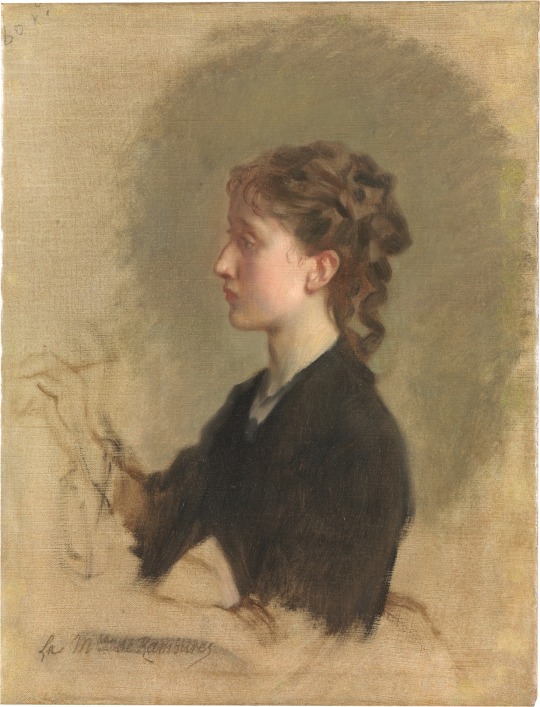
About the painting:
Louise Amour Marie de Bouillé, born in 1844, married in 1864 the French Count Charles Antoine de La Roche-Fontenilles, who also used the title of Marquis of Rambures.
This portrait is absolutely unique in Madrazo’s work, as it offers an intermediate stage between the sketch and the finished portrait. It was more tan probably done in a single, short session, and intended to be gifted to the model herself.
She appears sitting, almost, but not quite, in profile, ready to start painting. Her face is drawn with just a few, subtle strokes; the delicate coloring emphasized the elegance and languor of her features. This effective use of colour, in conjunction with the soft lighting, contributes to the overall intimate and private feel of the whole painting.
Here you can appreciate a close-up of how subtle the lighting and overall flesh colour: look at her cheeks
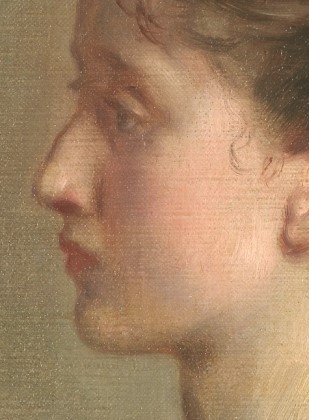
In this close-up, you can appreciate just how few strokes were necessary for him to give “life” to her hair:
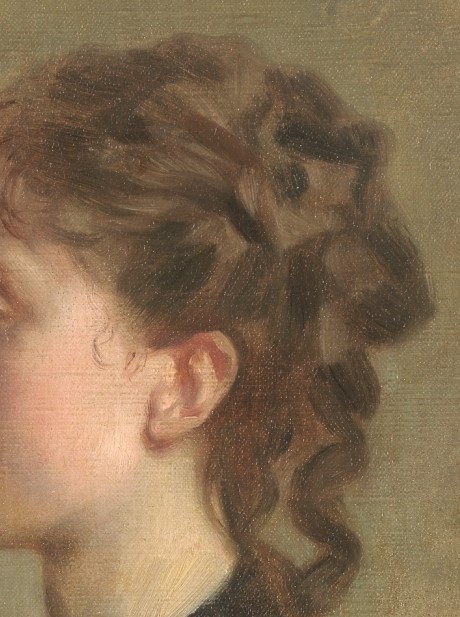
About the Author:
Federico de Madrazo y Kuntz (9 February 1815 – 10 June 1894) was a Romantic Spanish painter.
From a family with artists on both sides, he studied in Madridm the the Real Academia de Bellas Artes de San Fernando, and then went to Paris to study with Ingres (a friend of his father) and where he entered into contact with French Romanticism. He also stayed in Rome for two years, before returning to Spain.
He was the Court Painter for Queen Isabel II, and was later director of the Prado Museum and of the Real Academia de Bellas Artes de San Fernando.
I just wanted to highlight that he has some very famous portraits (his specialty) such as the Portrait of María Amalia del Llano y Dotres, 1st Countess of Vilches.
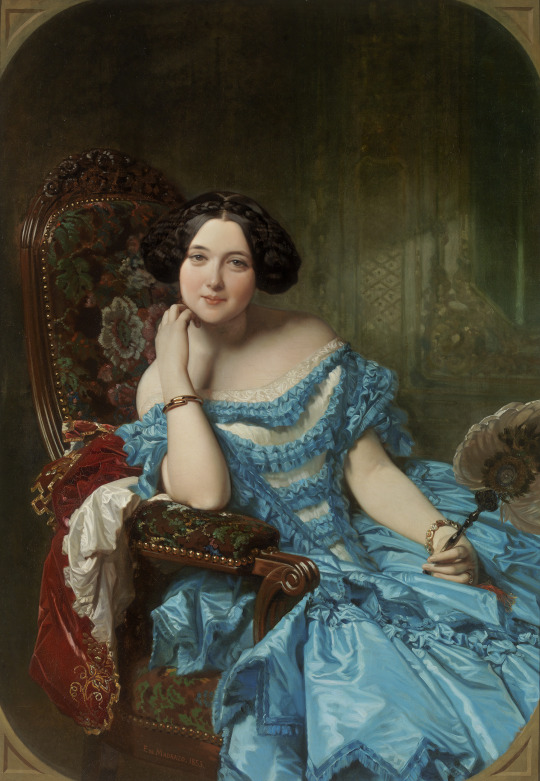
#study notes#studyblr#Study resources#studyspo#studyinspo#art#romanticism#spanish painter#lifelong learning#LifeLongLearning#justalifelonglearner
8 notes
·
View notes
Text
20/11/2019
Today I’m reading an old friend. This particular edition, I found in a closing second-hand bookstore in Antwerp.
I do not think the photos make it justice; the cover is a beautiful rusted blood red, and the spine has been worn down until it becomes this reddish gold.
Also, the first photo looks much redder in Tumblr than it does in my camera roll.



4 notes
·
View notes